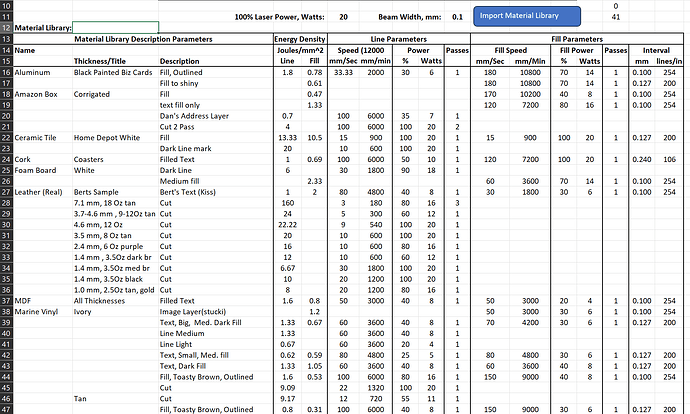I developed a macro-enabled Excel workbook which imports a Material Library .clb file, and displays the cut information nicely (see below for a portion of my library). My motivation was to calculate the energy flux (Joules/mm^2, same as Watt-Sec/mm^2) for each type of cut (line, fill and image), just for comparison purposes. I would be glad to share the workbook, but I see no way of uploading such a document to this forum. (and I think that’s an appropriate policy for this forum by the way). If anyone has a burning desire to have the workbook and knows of another means of sharing it, let me know…Jack
I believe the forum software will let most anything thru if you change the filename extension to .txt
I would like a copy. Agree with Cgg maybe just change extension to .txt
OK, I’ll give that a try
MatLib Formatter.txt (63.2 KB)
Remember to change the extension to .xlsm, a macro-enabled Excel file, If you are able to open it, it will give you a warning on the first run that it could be dangerous. Just say OK to that.
If you have experience with Visual Basic for Applications (the macro language for Excel, you can see the code by enabling the Developer tab in the top Excel menu, and looking at the Visual Basic icon. I wrote it to handle one or two sublayers for a given cut, of types line, fill and layer, in any order. With first use, you will have to search a bit for the location of you Material Library file, then it remembers the folder path to it on subsequent runs. For image types it appends the dither method to the description column entry.
Good luck, and please inform me of any problems you might have…
Besides uploading disguised as a .txt you could use dropbox, onedrive, or some other free access file sharing site. Or probably through MS365 if you are using the cloud version of Excel or if the desktop version will kick it to the cloud for you.
I have been interested in the same energy per mm/2 comparison myself as I know there are a few different combinations of spee/power/interval that can result in the same amount of energy on target.
As a suggestion, just add the .txt extension. Then it’s clear what the basic file is related too.
MatLib Formatter.txt would be easier to interpret if it were MatLib Formatter.xlsm.txt
Make sense?
![]()
Yep, that would have been better. Good thought for the future…
That’s what I always suggest too for that very reason.
This topic was automatically closed 30 days after the last reply. New replies are no longer allowed.
